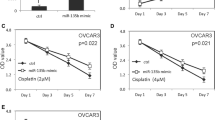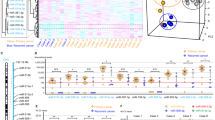Abstract
MicroRNAs play critical roles in regulating tumor occurrence and drug sensitivity in ovarian cancers. This study aimed to investigate the key members of MicroRNAs (miRNAs) involved in modulating tumor initiation and drug resistance in primary ovarian cancer cells. An in vitro assay based on tumor clonal formation was established to evaluate tumorigenicity and cisplatin sensitivity. By performing real-time polymerase chain reaction, we examined the expression of nine microRNAs associated with the pathology of ovarian cancers in primary ovarian tumor cells, which were surgically resected from 46 patients with distinct sensitivity to platinum-based chemotherapy. MiR-9, miR-145, and miR-429 were expressed significantly higher in drug-sensitive patients (n = 26) than in drug-resistant ones (n = 20), while higher miR-26a expression was found in resistant patients (p < 0.05). In addition, tumor cells from drug sensitive patients were more tumorigenic than those of drug resistance (p = 0.0013). Cisplatin treatment led to a sharp decrease of clonal formation of drug-sensitive cells but showed slight effects on drug resistant cells. Specific anti-miRs were then employed to downregulate the expression of microRNAs in primary tumor cells. Inhibition of miR-9 resulted in decreased clonal formation and sensitivity to cisplatin, while the knockdown of other three microRNAs did not show any influence in tumorigenesis and drug sensitivity. In conclusion, this study showed that in primary ovarian tumor cells, high expression of miR-9 was associated with enhanced tumorigenesis and increased sensitivity of the tumor cells to cisplatin treatment.




Similar content being viewed by others
References
Samrao D, Wang D, Ough F, Lin YG, Liu S, Menesses T, et al. Histologic parameters predictive of disease outcome in women with advanced stage ovarian carcinoma treated with neoadjuvant chemotherapy. Transl Oncol. 2012;5:469–74.
Jemal A, Siegel R, Xu J, Ward E. Cancer statistics, 2010. CA: Cancer J Clin. 2010;60:277–300.
Bonanno L, Favaretto A, Rosell R. Platinum drugs and DNA repair mechanisms in lung cancer. Anticancer Res. 2014;34:493–501.
Chen X, Wu Y, Dong H, Zhang CY, Zhang Y. Platinum-based agents for individualized cancer treatment. Curr Molec Med. 2013;13:1603–12.
Chen Y, Zhang L, Hao Q. Olaparib: a promising parp inhibitor in ovarian cancer therapy. Arch Gynecol Obstet. 2013;288:367–74.
Kigawa J. New strategy for overcoming resistance to chemotherapy of ovarian cancer. Yonago Acta Medica. 2013;56:43–50.
Miao J, Wu S, Peng Z, Tania M, Zhang C. Micrornas in osteosarcoma: diagnostic and therapeutic aspects. Tumour Biol : J Int Soc Oncodev Biol Med. 2013;34:2093–8.
Shen DW, Pouliot LM, Hall MD, Gottesman MM. Cisplatin resistance: a cellular self-defense mechanism resulting from multiple epigenetic and genetic changes. Pharmacol Rev. 2012;64:706–21.
Sui X, Chen R, Wang Z, Huang Z, Kong N, Zhang M, et al. Autophagy and chemotherapy resistance: a promising therapeutic target for cancer treatment. Cell Death Dis. 2013;4:e838.
Bartel DP. MicroRNAs: genomics, biogenesis, mechanism, and function. Cell. 2004;116:281–97.
Kinose Y, Sawada K, Nakamura K, Kimura T. The role of microRNAs in ovarian cancer. BioMed Res Int. 2014;2014:249393.
Di Leva G, Croce CM. The role of microRNAs in the tumorigenesis of ovarian cancer. Front Oncol. 2013;3:153.
Iorio MV, Visone R, Di Leva G, Donati V, Petrocca F, Casalini P, et al. MicroRNA signatures in human ovarian cancer. Cancer Res. 2007;67:8699–707.
Oom AL, Humphries BA, Yang C. MicroRNAs: novel players in cancer diagnosis and therapies. BioMed Res Int. 2014;2014:959461.
Zaman MS, Maher DM, Khan S, Jaggi M, Chauhan SC. Current status and implications of microRNAs in ovarian cancer diagnosis and therapy. J Ovarian Res. 2012;5:44.
Davidson B, Trope CG, Reich R. The clinical and diagnostic role of microRNAs in ovarian carcinoma. Gynecol Oncol. 2014;133:640–6.
Liu L, Zou J, Wang Q, Yin FQ, Zhang W, Li L: Novel micrornas expression of patients with chemotherapy drug-resistant and chemotherapy-sensitive epithelial ovarian cancer. Tumour biology : the journal of the International Society for Oncodevelopmental Biology and Medicine 2014.
Nass D, Rosenwald S, Meiri E, Gilad S, Tabibian-Keissar H, Schlosberg A, et al. Mir-92b and mir-9/9* are specifically expressed in brain primary tumors and can be used to differentiate primary from metastatic brain tumors. Brain Pathol. 2009;19:375–83.
Khew-Goodall Y, Goodall GJ. Myc-modulated mir-9 makes more metastases. Nat Cell Biol. 2010;12:209–11.
Wan HY, Guo LM, Liu T, Liu M, Li X, Tang H. Regulation of the transcription factor nf-kappab1 by microrna-9 in human gastric adenocarcinoma. Mol Cancer. 2010;9:16.
Guo LM, Pu Y, Han Z, Liu T, Li YX, Liu M, et al. Microrna-9 inhibits ovarian cancer cell growth through regulation of nf-kappab1. FEBS J. 2009;276:5537–46.
Yu T, Liu K, Wu Y, Fan J, Chen J, Li C, Yang Q, Wang Z: Microrna-9 inhibits the proliferation of oral squamous cell carcinoma cells by suppressing expression of cxcr4 via the wnt/beta-catenin signaling pathway. Oncogene 2013.
Cekaite L, Rantala JK, Bruun J, Guriby M, Agesen TH, Danielsen SA, et al. Mir-9, −31, and −182 deregulation promote proliferation and tumor cell survival in colon cancer. Neoplasia. 2012;14:868–79.
Ma L, Young J, Prabhala H, Pan E, Mestdagh P, Muth D, et al. Mir-9, a myc/mycn-activated microRNA, regulates e-cadherin and cancer metastasis. Nat Cell Biol. 2010;12:247–56.
Zhao SF, Zhang X, Zhang XJ, Shi XQ, Yu ZJ, Kan QC. Induction of microrna-9 mediates cytotoxicity of curcumin against skov3 ovarian cancer cells. Asian Pacific J Cancer Prevent : APJCP. 2014;15:3363–8.
Wu H, Xiao Z, Wang K, Liu W, Hao Q. Mir-145 is downregulated in human ovarian cancer and modulates cell growth and invasion by targeting p70s6k1 and muc1. Biochem Biophys Res Commun. 2013;441:693–700.
Xie Z, Cao L, Zhang J. Mir-21 modulates paclitaxel sensitivity and hypoxia-inducible factor-1alpha expression in human ovarian cancer cells. Oncol Lett. 2013;6:795–800.
Zhu X, Li Y, Xie C, Yin X, Liu Y, Cao Y, et al. Mir-145 sensitizes ovarian cancer cells to paclitaxel by targeting sp1 and cdk6. Int J Cancer J Int du Cancer. 2014;135:1286–96.
Conflicts of interest
None
Author information
Authors and Affiliations
Corresponding author
Electronic supplementary material
Below is the link to the electronic supplementary material.
Fig. S1
(JPEG 1151 kb)
Rights and permissions
About this article
Cite this article
Zhao, HM., Wei, W., Sun, YH. et al. MicroRNA-9 promotes tumorigenesis and mediates sensitivity to cisplatin in primary epithelial ovarian cancer cells. Tumor Biol. 36, 6867–6873 (2015). https://doi.org/10.1007/s13277-015-3399-x
Received:
Accepted:
Published:
Issue Date:
DOI: https://doi.org/10.1007/s13277-015-3399-x




